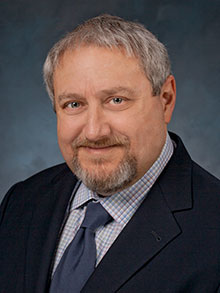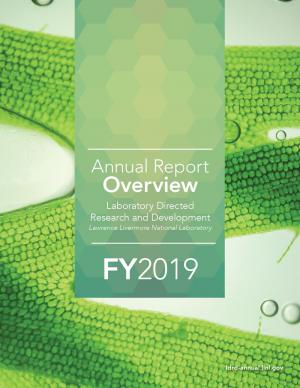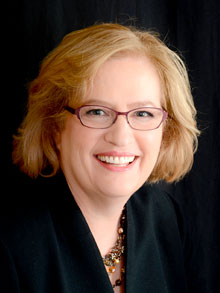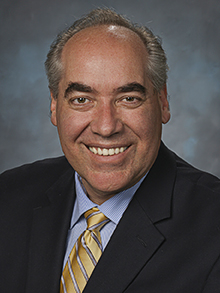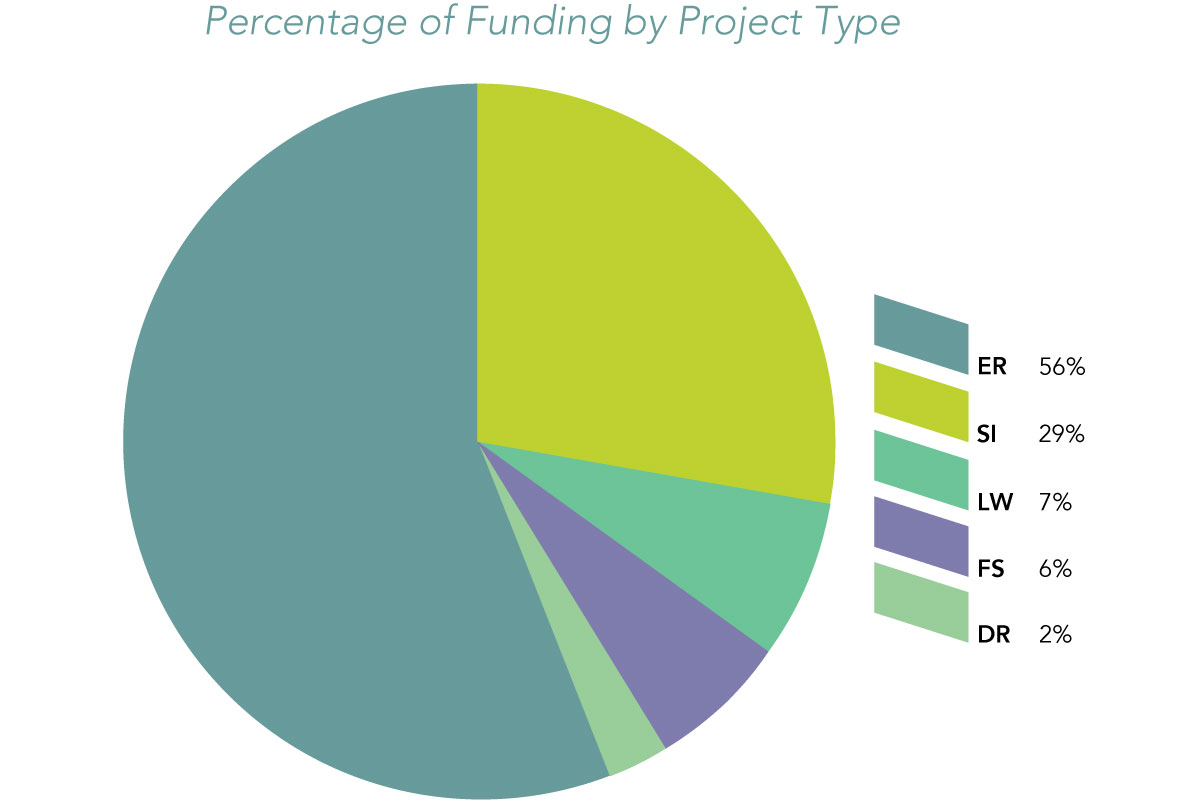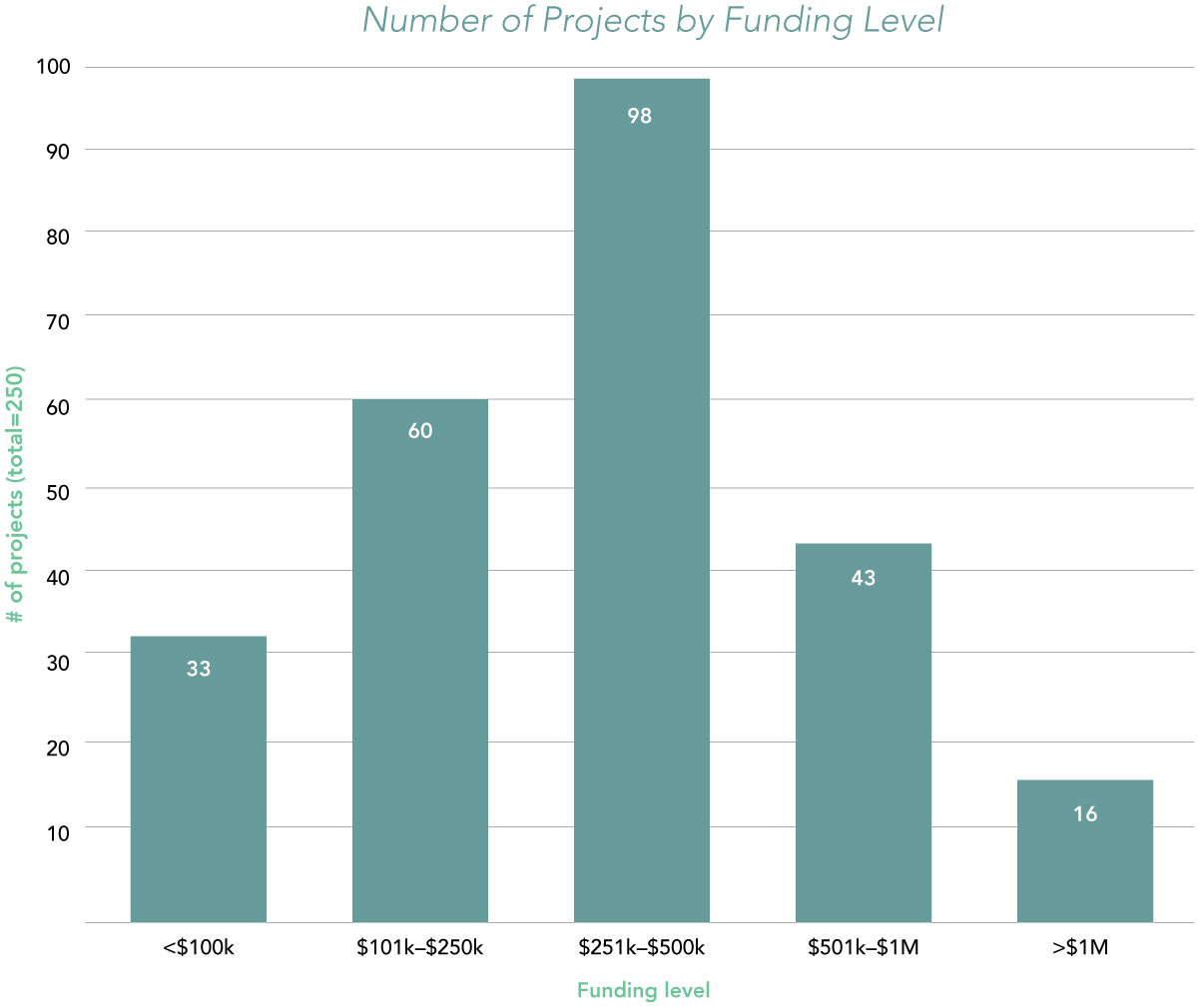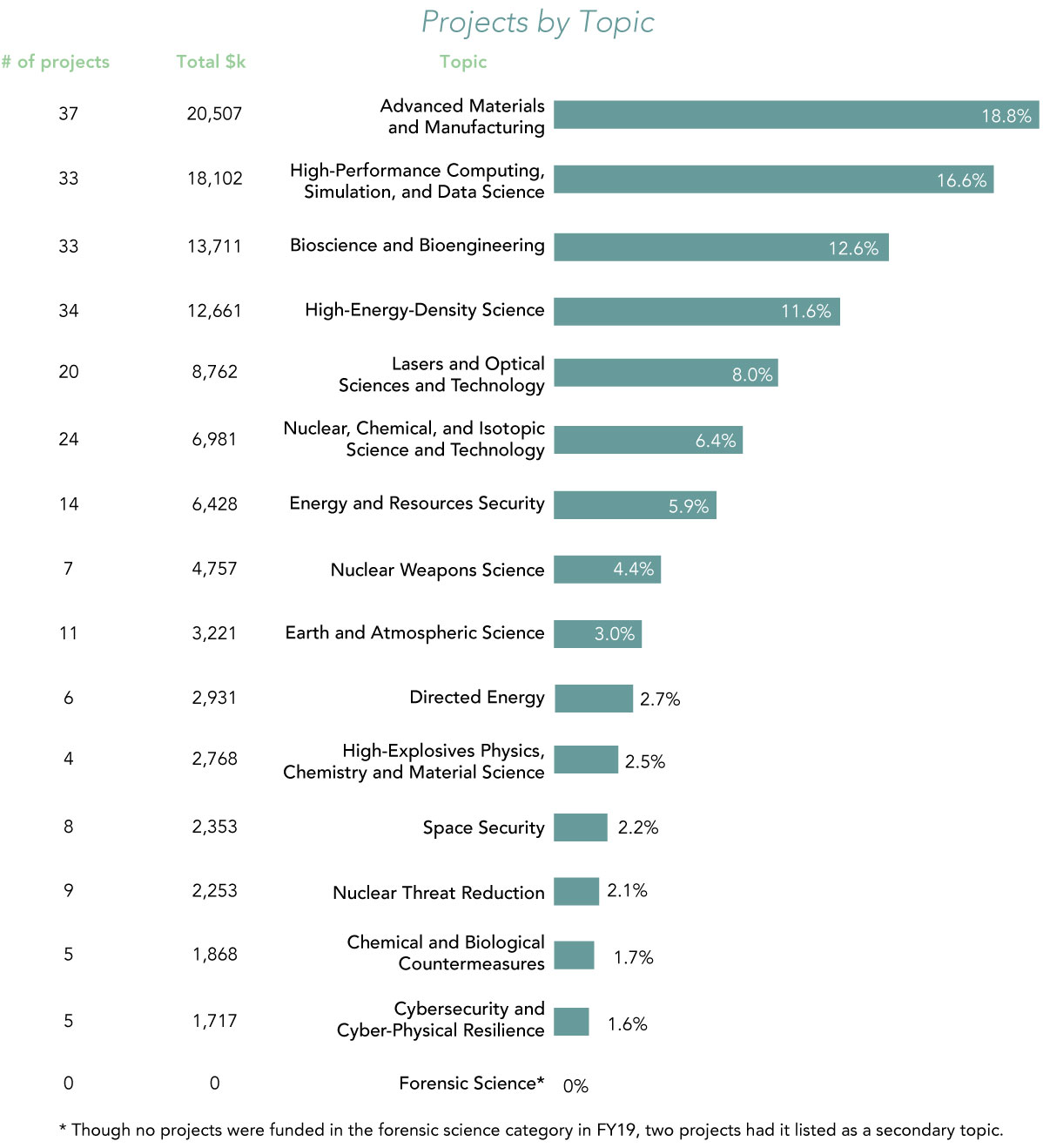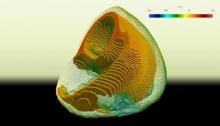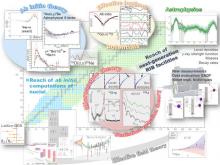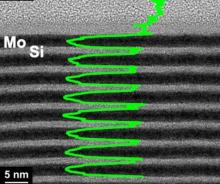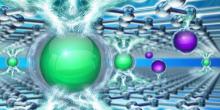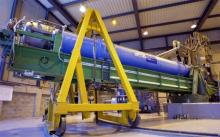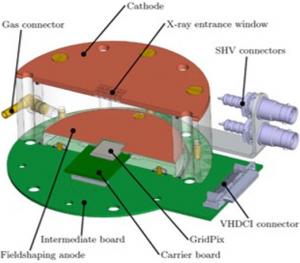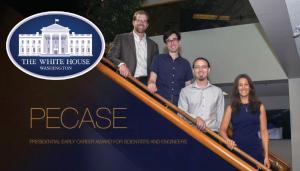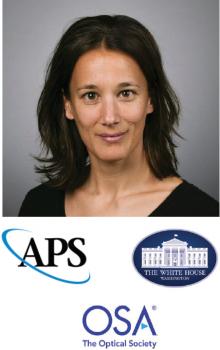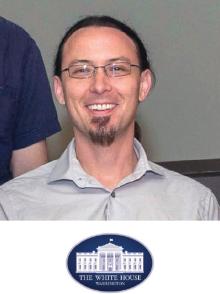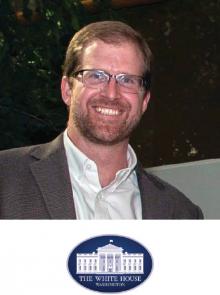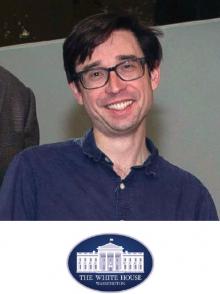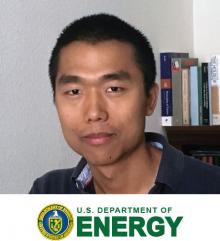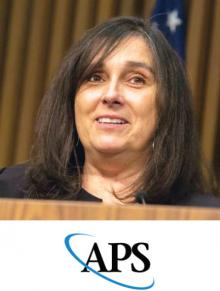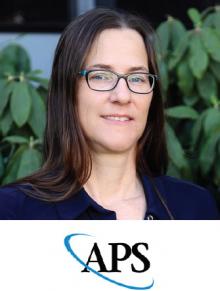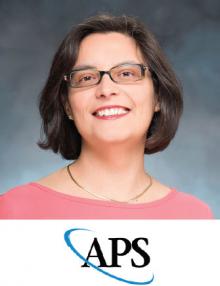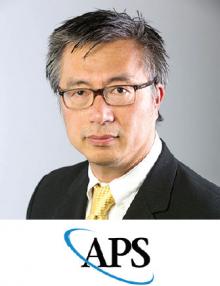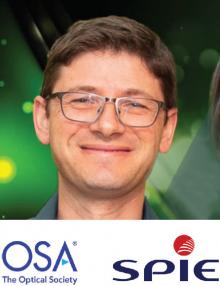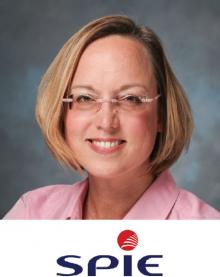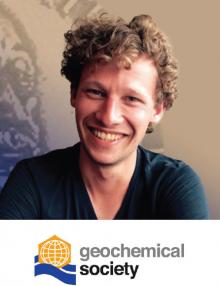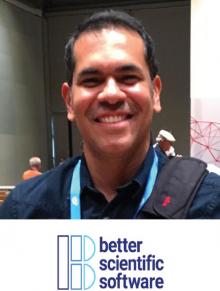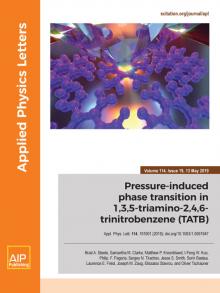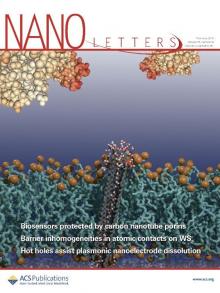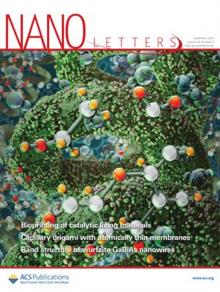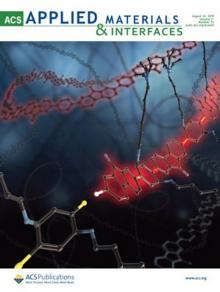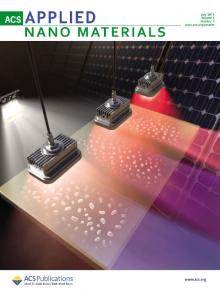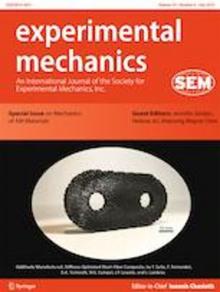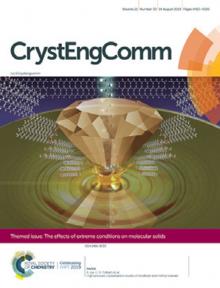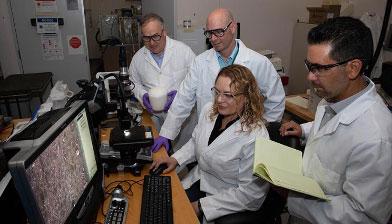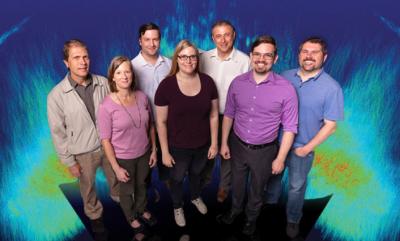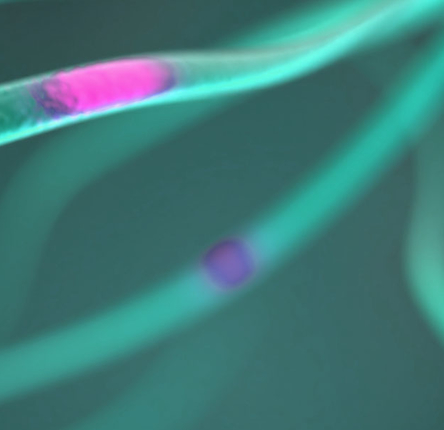Directors Statement
William H. Goldstein, Director
Our national security needs evolve as the world changes. In response, Lawrence Livermore National Laboratory strives to anticipate future national security challenges, maintain its core strengths, develop new capabilities required to fulfill mission requirements, and recruit talented staff to address the dynamic research needs of our missions.
The Laboratory Directed Research and Development (LDRD) Program is LLNL's most targeted effort to further every one of these objectives. LDRD-sponsored research keeps the Laboratory on the pioneering edge of science, attracts and helps retain talented researchers, and provides the Laboratory with the tools we need to carry out our mission of making the world a safer place.
Established by Congress in 1991, the LDRD program has allowed the Department of Energy's national laboratories to find new research areas ripe for investigation and adapt to changing needs. In Fiscal Year (FY) 2019, the LLNLLDRD program supported 250 projects funded at a total of $109 million.
The program's funding awards are highly competitive. All LDRD proposals are reviewed in a rigorous process to ensure that the winners have scientific merit, address one or more of the security missions of LLNL, and show promise of interesting and innovative results that could lead to new research directions and approaches to our work.
In this report, you can read about a great variety of research, ranging from developing new nanomaterials that are relevant to LLNL's mission of maintaining the safety, security, and effectiveness of the nation's nuclear stockpile, to building bioengineered systems that model human organs to assist with developing countermeasures to biological threats, diseases, and neurological conditions.
The record of innovations that stem from LLNL's LDRD program is a long one, and some of those innovations have led to new research programs at Livermore. LDRD-funded work has helped Livermore build research programs in such areas as advanced materials development, bioscience and bioengineering focused on biosecurity, and technologies for space science.
Livermore has always strived to be the “new ideas” laboratory—a direction established by its founders. The LDRD Program has been instrumental in attracting a diverse, talented workforce to LLNL and providing the support researchers need to conceive new ideas and develop them into the science and technology essential to making the world a more secure place.
How to Read This Report
The LDRD FY19 annual report contains two parts:
- The overview. This section introduces readers to Lawrence Livermore National Laboratory and the LDRD program, describes the program's structure and management, and provides an update on portfolio statistics, scientific accomplishments, and metrics of performance.
- Individual project reports. This section contains detailed final reports of all projects that concluded in FY19. Final reports contain a project overview and a summary of the impact of the project to DOE, NNSA, and Laboratory missions. A cumulative list of the publications and presentations produced over the project's duration is also provided. This section also contains brief descriptions of projects that are ongoing.
Project reports are organized by field of research and project type, such as feasibility studies, exploratory research, and so on. (See section "Types of Projects" for a complete list of project types and descriptions).
Every project is assigned a three-element tracking code:
- The first element is the fiscal year in which the project began.
- The second represents project type.
- The third identifies the serial number of the project within its fiscal year.
For example, the tracking code "19-FS-001" identifies a feasibility study that began in FY19, with a serial number of 001.
Note that some project reports are withheld from publication due to classification but are available through the appropriate channels.
The Laboratory Directed Research and Development Program at LLNL
Congress established the LDRD program at the DOE national laboratories in 1991 to foster excellence in science and technology and to ensure the laboratories are technically vital and prepared to meet today's needs and tomorrow's challenges. LDRD achieves this by supporting high-risk, potentially high-payoff research and development projects. At LLNL, this program provides the most significant resource for internally directed scientific and technical investments.
Program Mission
According to DOE Order 413.2C, the LDRD Program serves to
- support the missions, strategic vision, and core competencies of the DOE/NNSA and LLNL;
- maintain the Laboratory's science, technology, and engineering vitality;
- attract and retain the most qualified scientists and engineers and allow scientific and technical staff to enhance their skills and expertise;
- pursue collaborations with academia, industry, and other government laboratories;
- generate intellectual property; and
- strengthen the U.S. economy.1
To fulfill its mission, LDRD funds leading-edge research and development while helping to recruit, train, and mentor top talent in new and emerging fields. For example, the program typically supports about 50% of the Laboratory's postdoctoral researchers who are internationally respected in their fields (see "Awards and Recognition"). Many of them become career employees. LDRD also supports the basic research that is instrumental to enhancing the core competencies of the Laboratory and applies those competencies in novel ways to achieve national security mission goals, often forming the foundation of new programs. Furthermore, with its emphasis on creative science and novel methods, LDRD research often leads to inspired collaborations, intellectual property, and technical innovations that are transferred to industry. (For examples, see "Long-Term Impacts of LDRD Investments.") Altogether, Livermore's technical strength and agility—as well as its status as a premier research institution—are, in large part, a product of LDRD investment choices.
Program Leadership
William H. Goldstein
Patricia Falcone
Doug Rotman
LLNL Director William Goldstein and Deputy Director for Science and Technology Patricia Falcone were responsible for the Livermore LDRD program in FY19. Execution of the program was delegated to the LDRD program director, Doug Rotman. The LDRD program at Livermore complies fully with DOE Order 413.2C and relevant DOE orders and guidelines.
Oversight
The LDRD program achieves continual improvement through internal and external reviews of program management, execution, and oversight of each LDRD project. In accordance with DOE Order 226.1B2 of the prime contract between NNSA and Lawrence Livermore National Security, LLC, a contractor-assurance system is in place at the Laboratory; the LDRD office uses this system and its tools provided to support improvements in LDRD program performance.
In May 2016, the director of the Office of Science, Cherry A. Murray, asked the Advanced Scientific Computing Advisory Committee (ASCAC) to perform an independent review of the LDRD program, the purpose being to consider the overall impact of LDRD in four representative laboratories (including Livermore, the sole NNSA facility represented). The ASCAC subcommittee engaged in extensive written dialog with representatives of the chosen LDRD programs and also made site visits to the laboratories. Overall, the ASCAC subcommittee's review was very positive concerning both the LDRD program as a whole and Livermore's program specifically. Their sole recommendation to LLNL concerned the improvement of tracking the long-term impacts of projects. The report observes, "Planned efforts by LLNL to enhance on-going processes for collecting metrics associated with LDRD programs should better allow them to monitor the long-term impact of LDRDs and demonstrate their success. LLNL should discuss these efforts with the other DOE Labs...."3
Toward that end, representatives from the LLNL LDRD program are participating in a working group with other DOE/NNSA laboratories to share best practices and discuss strategies for tracking the long-term impact of LDRD investments. Specifically, in FY18, a subcommittee of the working group was formed to
- formulate a strategy to define long-term impacts,
- determine the metrics by which the long-term impact of LDRD investments can be measured,
- assess and select the methods by which such metrics can be tracked, and
- begin cataloging the impact of projects.
In FY19, the subcommittee developed draft numerical success metrics and a standard format to report long-term LDRD success stories.
Alignment with DOE, NNSA, and Laboratory Missions
Aligning LDRD projects with DOE, NNSA, and Laboratory missions begins with a process to set institutional goals at the Laboratory level by identifying (a) mission-related challenges or areas of interest for high-priority research, (b) the core competencies that support this high-priority research, (c) the scientific and technological needs to address those challenges and enhance related competencies, and (d) key topics in fundamental research. Published as the Investment Strategy for Science and Technology,4 this living document is overseen by multidisciplinary teams under the guidance of the deputy director for science and technology and is revised annually to respond to evolving mission needs. This document sets the strategic context for the annual LDRD calls for proposals. Other context-defining publications include the DOE's Strategic Plan, 2014–20185 and the NNSA's Enterprise Strategic Vision, August 2015.6
At the programmatic level, LDRD portfolio management at Livermore is structured to guarantee alignment with DOE, NNSA, and Laboratory missions. The structure involves
- calls for proposals that underscore the requirement that projects align with DOE/NNSA missions,
- guidance to prospective applicants on how to work with the aforementioned publications to address DOE/NNSA mission needs in their proposals, and
- a peer-review process for strategic relevance and technical content to select the highest-quality LDRD portfolio from these proposals.
By adhering to the guidance of key documents and the program’s portfolio management structure, the Laboratory’s FY2019 LDRD program strongly supported DOE/NNSA goals in nuclear and national security and scientific discovery and innovation, as in years past.
Topics of Inquiry
Although LDRD projects frequently invoke more than one scientific discipline, each project is assigned to one of sixteen general categories identified in the Laboratory's science and technology investment strategy.
These categories consist of nine mission-driven research and development challenges and seven core competencies (the scientific and technical skills, abilities, and knowledge the Laboratory must command to address the research challenges).
The nine research and development challenges are as follows:
- Chemical and biological countermeasures. Provide innovative systems and capabilities to rapidly detect and effectively respond to intentional use of pathogens and chemical agents, as well as natural outbreaks of pandemic diseases.
- Cybersecurity and cyber–physical resistance. Advance cyber and network science to support U.S. cyber superiority and ensure the resilience of the complex cyber–physical systems throughout the nation's critical infrastructure.
- Directed energy. Develop compact, robust, efficient high-average-power lasers with high optical quality for a broad range of national security applications.
- Energy and resource security. Apply innovative science and cross-cutting energy and climate-change-adaptation technologies to assure national energy and resource security.
- Forensic science. Advance the state-of-the-art in chemical, biological, radiological, nuclear, and explosive as well as traditional forensics science to support a broad set of national security needs.
- High-explosive physics, chemistry, and material science. Improve our understanding and prediction of high-explosive behavior to support the nation's nuclear deterrent and keep the U.S. safe from emerging explosives and nuclear proliferation.
- Nuclear threat reduction. Develop innovative technologies and systems to prevent, detect, counter, and respond to the use or threatened use of nuclear weapons or weapons-usable materials.
- Nuclear weapons science. Provide scientific and technological innovation to ensure the safety, security, reliability, and effectiveness of the nation's nuclear weapons stockpile.
- Space security. Develop new capabilities to meet national challenges in space situational awareness and intelligence, surveillance, and reconnaissance.
The seven core competencies are in the following areas:
- Advanced materials and manufacturing. LLNL strives to meet NNSA and broader national needs for the responsive, cost-effective development of advanced materials and manufacturing processes and systems.
- Bioscience and bioengineering. Researchers work at the interface of biology, engineering, and the physical sciences to address national challenges in biosecurity, chemical security, bioenergy, and human health.
- Earth and atmospheric science. Scientists and engineers advance the frontier in Earth and atmospheric sciences to develop innovative capabilities that drive LLNL's energy and national security missions.
- High-energy-density science. LLNL provides international leadership in studying and controlling matter under extreme conditions of temperature and pressure.
- High-performance computing, simulation, and data science. Scientists and engineers support mission needs, advancing high-performance computing to understand and predict the behavior of complex systems, which includes providing leadership in the technically challenging drive toward exascale-class computing; developing and applying higher fidelity, realistic, and reliable science and engineering simulations; and creating scalable capabilities to manage and recognize patterns in big data.
- Lasers and optical science and technology. This competency entails designing, building, and reliably operating complex laser systems that dramatically advance the state-of-the-art to meet strategically important applications.
- Nuclear, chemical, and isotopic science and technology. Researchers advance fundamental understanding, scientific capabilities, and technologies in nuclear and particle physics, radiochemistry, analytical chemistry, and isotopic signatures to support LLNL's national security missions.
Types of Projects
LLNL LDRD projects are of five types: strategic initiatives, exploratory research projects, feasibility studies, Laboratory-wide competition projects, and disruptive research. Each type has its distinctive purpose, duration, and funding limits.
Strategic Initiatives (SI)
The purpose of an SI project is to achieve a leap forward in answering key science, technology, and engineering challenges identified in the Laboratory's investment strategy. The Laboratory director takes an active role in SI project selection and progress and in the dissemination of results. An SI project is usually large in scope, typically funded for up to three years at $1.5 to $3.5M per year, and conducted by a large, multidisciplinary, cross-organizational team of scientists and engineers.
Exploratory Research (ER)
An ER project typically engages a multidisciplinary, cross-organizational team of scientists and engineers in innovative R&D for the purposes of (1) forging a new direction for an existing program, (2) responding to a research challenge within a mission area, or (3) making a breakthrough that enlarges the Laboratory's core competencies and scientific reputation. ER projects, which are the majority of LDRD projects, are funded for up to three years, with an annual budget between $300K and $1.3M per year.
Feasibility Studies (FS)
An FS provides a flexible way for researchers to propose small, short-term projects to determine the feasibility of a particular technical approach to a mission-relevant science and technology challenge. Feasibility studies are limited to 12 months in duration, with a maximum funding of $150K.
Laboratory-Wide (LW) Competition
LW projects emphasize innovative basic research and outside-the-box thinking. To encourage the creativity of individual researchers, the LW component requires neither filtering by management nor alignment with the Laboratory's investment strategy, although alignment with DOE missions is mandatory. LWs are typically funded up to $275K per year for two years.
Disruptive Research (DR)
DR projects are exceptionally innovative and unconventional and have the potential to overturn fundamental paradigms or create fundamentally new research directions. The purpose of this component is to encourage innovators to pursue exciting, novel ideas. These projects are high-risk in order to create high-reward results. DRs are planned and budgeted for up to three years.
Structure of the FY19 Portfolio
The FY19 portfolio was carefully structured to promote the program's vigorous strategic vision and the long-term goals of DOE, NNSA, and Livermore.
The projects in the present annual report underwent stringent peer-review selection and continuous management oversight. In FY19, the LDRD program funded 250 projects, for a total allocation of $109M.
Project Type Distribution
The distribution of funding among the project categories is shown in the following pie chart.
Strategic Initiatives. Fourteen SI projects were funded in FY19. Although SIs represented 6% of the total number of LDRD projects for the year, they claimed 29% of the budget. The average funding for individual SI projects was $2.3M.
Exploratory Research. In FY19, 139 ER projects constituted 56% of LDRD projects and 56% of the budget, making this category the largest in the portfolio. The average allocation for ER projects that were funded for the entire year was about $436K.
Laboratory-Wide Competition. Twenty-eight LW projects were funded in 2019, representing 11% of the projects for the year and 7% of the budget. Individual LW projects were allocated an average of about $259K.
Feasibility Studies. The program funded sixty feasibility studies in FY19, accounting for 24% of all LDRD projects and 6% of the budget. Many of these studies, which are limited to twelve months in duration, were funded for only part of the year because they began midyear in FY18 (and thus extended into FY19) or midyear in FY19 (in which case they will extend in FY20). Individual studies funded for the full fiscal year received an average of about $107K.
Disruptive Research. Nine DRs were funded in FY19, accounting for 4% of all LDRD projects and over 2% of the budget. The average funding of projects was about $307K.
Funding Distribution by Dollar Amounts
The following bar chart shows the distribution of funding by dollar amount, rounded to the nearest $1K increment, for all projects. Of all LDRD projects, 13% received less than $100K, while 24% received $100K–$250K. The largest cluster (39%) was in the $250K–$500K range. Projects in the $500K–$1M range accounted for 17% of the total; 6% received more than $1M. The average funding level was about $436K.
Distribution by Research Topic
The following chart breaks down the number of projects in each field of research and their percentage of LDRD funding. Of the two largest categories, advanced materials and manufacturing garnered about 19% of overall funding and high-performance computing, simulation, and data science, about 17% of overall funding, with 37 and 33 projects, respectively.
Metrics
By almost any measuring stick, the LDRD program contributes far more in intellectual property, publications, collaborations, and recruitment of postdoctoral researchers, dollar for dollar, than any other program at the Laboratory.
For instance, in FY19, LDRD costs at Livermore were $109M, 5.8% of the total Laboratory base; yet LDRD yielded well over half the Laboratory's patents. This section presents annual performance indicators specified by the Director of the Office of Science for LDRD at the DOE/NNSA laboratories, in accordance with DOE Order 413.2C.
Intellectual Property
Year after year, projects sponsored by LDRD achieve a disproportionately large percentage of the patents and copyrights issued for LLNL research. As illustrated in the following tables, LDRD has been key in developing two-thirds of the Laboratory's patents, one-fifth of the Laboratory's copyrights (chiefly computer code), and half of the Laboratory's records of invention.
| Patents | FY15 | FY16 | FY17 | FY18 | FY19 |
|---|---|---|---|---|---|
| All LLNL patents | 96 | 97 | 88 | 79 | 143 |
| LDRD patents | 46 | 54 | 55 | 41 | 95 |
| LDRD patents as a percentage of total | 48% | 56% | 63% | 52% | 66% |
| Copyrights | FY15 | FY16 | FY17 | FY18 | FY19 |
|---|---|---|---|---|---|
| All LLNL copyrights | 68 | 72 | 105 | 118 | 24 |
| LDRD copyrights | 21 | 19 | 19 | 23 | 24 |
| LDRD copyrights as percentage of total | 31% | 26% | 18% | 22% | 20% |
| Record of Invention | FY15 | FY16 | FY17 | FY18 | FY19 |
|---|---|---|---|---|---|
| All LLNL records | 122 | 91 | 110 | 105 | 129 |
| LDRD records | 65 | 43 | 53 | 47 | 24 |
| LDRD records as percentage of total | 53% | 47% | 48% | 45% | 50% |
Scientific Publications
Laboratory scientists and engineers publish over a thousand papers each year in a wide range of peer-reviewed journals, of which LDRD-funded work accounts for an increasingly large portion. For each year listed in the following table, the number of LDRD-derived publications should be considered a minimum value, and the true value larger, because the long-term impact of LDRD investments is manifest in publications that may appear long after the project has ended.
| Journal Articles | FY15 | FY16 | FY17 | FY18 | FY19 |
|---|---|---|---|---|---|
| All LLNL articles | 1,010 | 1,041 | 1,126 | 1,178 | 1,281 |
| LDRD articles | 265 | 265 | 274 | 456 | 553 |
| LDRD articles as percentage of total | 26% | 25% | 24% | 39% | 43% |
Collaborations
External collaborations are essential to the conduct of research and development in LDRD. By working formally and informally with other national laboratories, academia, and industry, LDRD investigators access leading facilities and knowledge in the U.S. and abroad. Recent data on formal collaborations, defined as those in which an external collaborator received LDRD funds from LLNL, are given in the following table.
| Collaborations | FY15 | FY16 | FY17 | FY18 | FY19 |
|---|---|---|---|---|---|
| Projects with one or more formal collaborations | 31 | 45 | 62 | 74 | 74 |
| Percentage of all projects | 20% | 25% | 29% | 31% | 30% |
Informal collaborations, in which the LLNL principal investigator and team intend to publish their work jointly with external collaborators, provide an indication of the broad intellectual engagement and scientific benefit of LDRD collaboration.
Students and Postdoctoral Researchers
By funding exciting, potentially high-payoff projects at the frontiers of science, the LDRD program attracts top talent in new and emerging fields of science and technology. As shown in the following table, LDRD investments contribute to the health and robustness of LLNL's student and postdoctoral researcher programs.
| Students and Postdoctoral Researchers | FY15 | FY16 | FY17 | FY18 | FY19 |
|---|---|---|---|---|---|
| Students supported by LDRD | 102 | 102 | 127 | 138 | 60 |
| Percentage of all students | 23% | 19% | 22% | 22% | 23% |
| Postdoctoral researchers supported by LDRD ≥10% of their time | 102 | 107 | 137 | 167 | 170 |
| Percentage of postdoctoral researchers | 43% | 25% | 44% | 54% | 57% |
| Postdoctoral researchers converted to full staff | 35 | 25 | 31 | 52 | 46 |
| Percentage of all convertions | 90% | 69% | 53% | 71% | 68% |
Research Highlights
This section provides a sampling of research projects from this year’s portfolio, representing a range of categories and various stages of completion. For reference, project numbers that begin with 16 were launched in FY16 and are now complete; those beginning with 17, 18, or 19 were launched in FY17, 18, or 19, respectively, and may still be continuing.
Project: Pioneering Stable Isotope Signatures of Nuclear Proliferation | 18-ERD-016
Principal investigator: Jennifer Matzel
Mission or competency: nuclear, chemical, and isotopic science and technology
Executive summary: LLNL researchers developed the NanoSIMS 50, a high-spatial resolution secondary ion mass spectrometer, to image fuel pellet uranium isotopic composition. The NanoSIMS 50 can detect distinct microscale variations in pellet composition not detectable using conventional techniques, making it a more selective tool for nuclear forensic analysis to determine the provenance of illicitly traded nuclear materials.
Uranium dioxide is the most commonly used fuel type in nuclear reactors worldwide, with fuel fabrication facilities producing hundreds of uranium pellets per minute. Illicit trafficking of uranium dioxide fuel pellets is a recurring phenomenon. Until recently, the analysis and identification of nuclear fuel pellets in nuclear forensics investigations have been mainly focused on macroscopic characteristics, such as pellet dimensions, uranium enrichment, and other reactor-specific features, but LLNL scientists have found that studying pellets at the microscale could improve nuclear forensic analysis by determining more effectively where the material came from and how it was made.
LLNL researchers used LLNL’s NanoSIMS 50, a high-spatial resolution secondary ion mass spectrometer, to image fuel pellet uranium isotopic composition in situ. NanoSIMS imaging of pellet fragments showed distinct microscale variations in the uranium isotopic composition. These variations were not detected using the conventional bulk techniques applied to these materials. NanoSIMS imaging analysis allowed direct characterization of the spatial heterogeneity of the uranium isotopic composition of the surface of fuel pellet fragments and the relationship of that heterogeneity to crystal structure. The research appears in the journal Analytical Chemistry.
Mission impact: This research advances LLNL’s abilities to carry out its mission in nuclear forensics, which addresses the mission area of reducing nuclear threats. NanoSIMS will now be part of LLNL’s analytical toolbox in support of nuclear forensics investigations, providing a significant boost to its core competency in nuclear, chemical, and isotopic science.
Project: A Machine Learning System to Guide Clinical Procedures in Real-Time | 18-LW-078
Principal investigator: Robert Blake
Mission or competency: high-performance computing, simulation, and datascience; bioscience and bioengineering
Executive summary: Cardioid, a suite of codes that simulates the electrical current running through heart tissue, has been optimized for next-generation graphics processing unit-based supercomputers. The software rapidly assesses the impact of candidate pharmaceuticals on the heart.
A team of LLNL researchers successfully optimized a code that models the human heartbeat to run on next-generation, graphics processing unit (GPU)-based supercomputers, with an eye on developing it for virtual drug screening and modeling heart activity in clinical settings. Cardioid, a suite of codes merging mathematical solvers for electrophysiology, fiber generation, cardiac mechanics, electrocardiograms (ECGs), and cardiac meshing tools, simulates the electrical current running through heart tissue, triggering cells to contract like cascading dominoes, and causing a heart to beat. It was originally developed by LLNL and IBM to run on Sequoia, at one time the world’s fastest supercomputer, and was a finalist for the 2012 Gordon Bell Prize, supercomputing’s top honor.
This LDRD project combines Cardioid with machine learning and data from electrocardiograms to determine how the heart is functioning. Using a simple ECG voltage reader, doctors could plug the heart’s electrical activity data into a cellphone to generate a “3-D electrical stethoscope.” Preliminary results show the approach is working well. Potentially, the technology could be deployed in every operating room. Such simulations can generate virtual data that can be used to train machine learning algorithms, which could eventually lead to even more sophisticated predictive software tools for medical use.
Simulation provides a faster and less expensive way to test pharmaceuticals and medical procedures. Cardiac testing is dangerous to patients. High-performance computing benefits medical science by reducing the need for testing and providing alternative methods of developing medical countermeasures. Toward that end, the team hopes to work with the Food and Drug Administration to develop Cardioid for use in a clinical setting and someday virtually screen potential new prescription drugs for their effect on the heart without having to test the drugs on animals.
Mission Impact: This research helps provide the ability to prove that pharmaceutical countermeasures to biological agents are safe and will not negatively affect the heart’s functions.
Project: Nucleosynthesis for Science and Security | 16-ERD-022
Principal investigator: Nicholas Scielzo
Mission or competency: nuclear, chemical, and isotopic science and technology
Executive summary: Executive summary: Understanding neutron-capture cross sections (the quantitative measure for the strength of a nuclear reaction) is necessary for the safe operation of nuclear reactors and helps ensure the stockpile’s reliability without a return to nuclear testing. A collaboration led by LLNL demonstrated that neutron-capture cross sections can be determined through measurements of the (d,p) (deuteron, proton) reaction.
Although the neutron-capture reaction only adds a single neutron to a nucleus, it plays an important role in our lives. Understanding neutron-capture cross sections (the quantitative measure for the strength of a nuclear reaction) is necessary for the safe operation of nuclear reactors and helps ensure the stockpile’s reliability without a return to nuclear testing. Many nuclei that participate in neutron-capture reactions are radioactive, making direct measurements of the neutron-capture cross section extremely difficult or impossible. However, the importance of some of these cross sections necessitates developing techniques to determine them indirectly. One such approach is the surrogate reaction method, in which a reaction that can be studied in the laboratory is selected to form the same nucleus as is produced in the neutron-capture reaction. The decay of this nucleus can then be measured, from which the cross section of the neutron-capture reaction can be determined.
A collaboration led by LLNL demonstrated that neutron-capture cross sections can be determined through measurements of the (d,p) (deuteron, proton) reaction. The resulting neutron-capture reaction cross section is in excellent agreement with previous direct measurements of this reaction, demonstrating the validity of the surrogate reaction method and the utility of the (d,p) reaction as surrogate for the neutron-capture reaction. However, even using the surrogate reaction method, many other neutron-capture reaction cross sections of interest to stockpile stewardship or nuclear astrophysics involve nuclei that are out of the reach of current radioactive ion beam facilities. To answer this need, DOE has funded the Facility for Rare Isotope Beams (FRIB) at Michigan State University, which will be the nation’s premier radioactive ion beam facility when it begins delivering beams in 2022. The successful development of this surrogate reaction method is a key step in allowing the LLNL team to take advantage of FRIB beams.
Mission Impact: This research will enable breakthroughs in the understanding of reactions on radioactive nuclei at the FRIB, which is relevant to LLNL's core competency in nuclear, chemical, and isotopic science and technology. Developing approaches needed to determine neutron-induced reactions on radioactive isotopes is also relevant to the core competency of nuclear weapons science and NNSA's goal to maintain the safety, security, and effectiveness of the nation’s nuclear deterrent without nuclear testing.
Project: Advanced Multilayer Systems for National Security | 17-SI-001
Principal investigator: Tommaso Pardini
Mission or competency: advanced materials and manufacturing
Executive summary: Researchers have studied a molybdenum–silicon non-periodic multilayer interference mirror, determining features that optimize its performance. These mirrors are essential to x-ray optical systems used in many high-average-power pulsed laser systems such as the National Ignition Facility. The results will help extend the life and performance of these facilities.
Multilayer interference mirrors are enabling components in x-ray optical systems. These mirrors consist of periodic or non-periodic structures of alternating thin film layers of two or more materials deposited on an optical substrate. To extend laser lifetime and improve performance, today’s applications and experimental facilities (including the National Ignition Facility) require novel, multilayer-based hard x-ray optics that are beyond the current state-of-the-art. The realization of hard x-ray multilayers is a challenging task because it requires layers with thickness equivalent to a few atomic monolayers with stable layer interfaces. Interfacial effects (roughness, interdiffusion) directly control the magnitude of the reflectance, and in non-periodic multilayers, they can also drastically alter the shape of the spectral response. Furthermore, in non-periodic multilayers, the thickness, morphology, and composition of each interface may depend on the constituent layer thicknesses.
LLNL researchers have made a comprehensive study and optimization of molybdenum–silicon non-periodic multilayers operating at 17.4 kiloelectronvolts of photon energy. Molybdenum–silicon multilayers for much lower soft x-ray photon energies were developed at LLNL 30 years ago, but the multilayer structures were periodic (layer thicknesses were constant across the structures rather than varying), and the layers were much thicker than those in the current study. The researchers found that these differences resulted in dramatic changes in the physics of the layers and their interfaces, as well as unique challenges in the design and calibration of the non-periodic molybdenum–silicon multilayer films. They determined that the reflectance of these structures is maximized when boron carbide “barrier” layers are inserted at the layer interfaces to limit inter-diffusion. Surprisingly, they achieved maximum reflectance with barriers on the molybdenum-on-silicon interfaces only, rather than on both molybdenum-on-silicon and silicon-on-molybdenum interfaces.
Mission Impact: Improved coatings help extend the lifetime and performance of high-average-power pulsed-laser systems for scientific applications and lasers for emerging, directed-energy systems. This research also supports LLNL's core competency in lasers and optical science and technology and enhances its mission in the space security area.
Project: Selective Removal of Ions from Aqueous Solutions | 18-ERD-024
Principal investigator: Patrick Campbell
Mission or competency: advanced materials and manufacturing; earth and atmospheric sciences
Executive summary: This research provides a pathway to engineering materials to selectively remove particular ion species using capacitive deionization, a robust and low-maintenance path for efficiently and cost-effectively eliminating salt from seawater and brackish water.
In an effort to boost energy storage and the effectiveness of water desalination technologies, LLNL scientists studied in detail the adsorption of ions on carbon electrodes. They found that capacitive performance and ion selectivity of porous carbon is controlled by a complex interplay between confinement effects, the size and hydration energy of the ions, and the charge transfer between the electrode and the ions. Specifically, the team used high-fidelity quantum simulations and electrochemical measurements to investigate the adsorption of several alkali metals in ultramicroporous carbon aerogel electrodes.
A process known as capacitive deionization (CDI), used to separate ions from water, is based on selective adsorption. CDI is a robust and low-maintenance path for efficiently and cost-effectively removing salt from seawater and brackish water. CDI’s performance relies extensively on the adsorption ability of ions on electrode materials in aqueous environments. However, a detailed understanding of the mechanism of this process remains largely unknown. This LDRD project provides not only a good understanding of ion selectivity in CDI, but also key factors that determine the structure and electrical response of aqueous solutions at graphitic interfaces, knowledge that will help researchers tune CDI to remove any specified ion from water. The results were published in Nature Communications.
Mission Impact: This project supports Livermore's chemical and isotopic science and technology core competency. Developing a method to selectively remove particular ions contaminating water addresses Livermore’s mission in energy and resource security by providing technology to mitigate drinking water scarcity. The work may also be relevant to energy technologies involving ionic exchange at electrodes and other interface materials.
Project: Next-Generation Search for Solar Axion Dark Matter with the International Axion Observatory | 17-ERD-030
Principal investigator: Julia Vogel
Mission or competency: space science
Executive summary: LLNL is participating in the CERN Axion Solar Telescope Collaboration, which recently set a new best upper limit on the chameleon photon coupling. Chameleons are one of the leading candidates for dark energy .
The latest results published by the CERN Axion Solar Telescope (CAST) Collaboration set a new best upper limit on the chameleon photon coupling. Chameleons are one of the leading candidates for dark energy (axion-like particles, the detection of which requires technological advances aligned with those for axion detection). Non-linear self-interaction and interactions with matter cause chameleons to have an “effective mass” depending on the ambient mass (energy) density. Because the physical properties depend sensitively on the environment, the proposed scalar field was dubbed “chameleon.”
The CAST GridPix detector used to achieve these new results features an InGrid structure (combination of a gas amplification stage and a highly pixelized readout) and a TimePix application-specific integrated circuit. This GridPix detector was used at CAST to search for soft x-ray photons in the energy range from 200 electronvolts to 10 kiloelectronvolts from converted solar chameleons. The detector delivered results improving on previous world-leading CAST limits by a factor of two. The CAST researchers, including LLNL staff, have been using an x-ray telescope coupled to the GridPix detector to achieve the above-mentioned results and plan on further improving the bounds on solar chameleons with future data from optimized detection systems.
Mission Impact: Participation in space science is an important element in Livermore's space security research efforts. Providing next-generation capabilities for space security requires a trained workforce with demonstrated excellence in designing, fabricating, and performing science with advanced instrumentation. This research with a Livermore-built x-ray telescope and the design of a next-generation optic for axion dark matter searches using space science technology will establish and strengthen the Laboratory's preeminence in astroparticle physics, dark matter searches, x-ray optics, and instrumentation technology. The development of advanced x-ray optics also benefits areas of interest to DOE goals in energy and nuclear security with advances in diagnostics for laser fusion facilities and for nuclear nonproliferation.
Awards and Recognition
LDRD projects are distinguished by their mission-driven creativity, a characteristic that attracts the nation’s (indeed, the world’s) best and brightest scientists and engineers to LLNL. Inspired by a sense of purpose and a high standard of excellence, LDRD-funded research often launches stellar careers, initiates strategic institutional collaborations, produces game-changing technical capabilities, and even forms the foundation for entirely new fields of science. Empowered by the program, the impact our technical staff makes is often felt well beyond the DOE mission space.
It is no surprise then that every year, specific Livermore LDRD principal investigators are recognized for the groundbreaking results of a project or for long-term contributions to their fields. The following short list of stories attests to the exceptional talents of these researchers and underscores the vitality of Livermore’s LDRD program.
Four scientists from LLNL were selected for the prestigious Presidential Early Career Award for Science and Engineers (PECASE), the highest honor bestowed by the United States government on scientists and engineers who are early in their careers and have distinguished themselves in their respective fields. All four have been recipients of LDRD funding.
Established in 1996, the PECASE acknowledges the contributions scientists and engineers have made to the advancement of science, technology, education, and mathematics (STEM) education and to community service as demonstrated through scientific leadership, public education, and community outreach.
Project: A Compact Femtosecond Hard X-Ray Source for Materials Characterization and High-Energy-Density Science | 13-LW-076
Project: Extending Laser-Driven X-Ray Sources to High-Energy-Density Science Facilities | 16-ERD-024
Principal investigator: Félicie Albert
Albert serves as a staff scientist in the National Ignition Facility and the Joint High Energy Density Sciences organization. She also is the deputy director for LLNL’s Center for High Energy Density Science. She was recognized for “innovative research advancing the development of Betatron X-rays from laser-wakefield accelerators as a novel probe for characterizing high energy density states of matter and for leadership through mentoring and service to the scientific community.” She was nominated by the Department of Energy’s Office of Science, Office of Fusion Energy Sciences.
“I was born and raised in France, and I became an American citizen in 2018, so for me getting a U.S. presidential award is kind of the American dream. It is such an honor to receive this, even more so that I am sharing it with three colleagues from LLNL whom I know are exceptional scientists,” Albert said. “This Lab really allows you to dream big and accomplish yourself as a scientist, and I have been fortunate to be supported by many colleagues and mentors since I have been here.”
In 2019, Albert was also named a fellow of the American Physical Society and a senior member of the Optical Society (OSA).
Project: Exploratory Design Study Towards the First Plasma-Electron Screening Experiment | 18-FS-010
Principal investigator: Daniel Casey
Daniel Casey is a physicist studying the properties and performance of inertial confinement fusion (ICF) implosions at the National Ignition Facility. He is co-leading a “principle degradations” effort to understand 3D areal-density asymmetries that threaten to damage and ultimately impact the quality of ICF implosions. Additionally, he is the experimental co-lead for a campaign that will test a high-temperature hohlraum along with campaigns within the ICF program that have successfully tested the impact of scale, velocity and adiabat on overall performance. He was recognized “for exceptional contributions and impressive creativity, and innovation in the measurement and understanding of instability and mix for the Inertial Confinement Fusion and High Density Physics Programs. He has consistently demonstrated leadership, originality and vision.” He was nominated by the National Nuclear Security Administration.
“It’s an extraordinary and humbling honor to be among the PECASE awardees this year,” Casey said. “That such a thing is even possible is a reflection of the amazing people at this Laboratory and a recognition of the valuable research that we accomplish together via teamwork. This award is proof that I am privileged to work with some of the most talented and versatile people in the world and remain humbly in their debt.”
Project: Melting and Solidification in Multicomponent Materials | 15-ERD-012
Principal investigator: Richard Kraus
Richard Kraus is a research scientist in the Physics Division at LLNL and serves as the project lead for an upcoming subcritical experiment at the Nevada National Security Site. He was recognized for “advancing the field of materials science, planetary science and material issues that are critical to the nuclear security mission, through elegant and innovative design, analysis and understanding of dynamic compression experiments using gas-gun, magnetic compression and laser sources.” He was nominated by the National Nuclear Security Administration.
“It’s truly an honor to be recognized and to be included in such an amazing cohort of early career scientists from around the country,” Kraus said. “I had many incredible mentors along the way that have made this achievement possible.”
Project: Particle Acceleration from Laser-Driven Collisionless Shocks | 15-LW-095
Principal investigator:Arthur Pak
Arthur Pak is a staff scientist at the National Ignition Facility, where his research is focused on understanding how to optimize the performance of ICF experiments. He was recognized “for the quantitative assessments and mitigation of radiation drive asymmetries in indirect drive inertial confinement fusion and for significantly contributing to the milestone achievement of 50kJ fusion yield in X-ray driven implosions at the National Ignition Facility.” He was nominated by the National Nuclear Security Administration.
“This award highlights the exciting and impactful results that can be accomplished through a large collective effort," Pak said. "I am very grateful for the opportunity to be able to work together with a group of truly amazing scientists and technical staff on these challenging and important problems.”
Project: An Alternative Rare Event Detector | 17-ERD-016
Principal investigator: Jingke Xu
Physicist Jingke Xu is a recipient of the Department of Energy’s (DOE) Office of Science 2019 Early Career Research Program (ECRP) award. Xu, a physicist in LLNL’s Nuclear and Chemical Sciences Division, was selected for his work in high-energy physics. He was among the 73 scientists nationwide who were selected for the recognition. Under this program, typical awards for DOE national laboratory staff are $500,000 per year for five years.
Xu works on the direct search for dark matter interactions with noble liquid detectors. The concept of dark matter—the idea that a large fraction of our universe exists in a form that has not been observed—has become a cornerstone of modern particle physics and cosmology, but the nature of dark matter remains unknown. His approach aims to boost the capability of xenon-based dark matter experiments by extending the high-sensitivity dark matter searches to low energies near the quantum limit. His proposed research is intended to enable xenon ionization detectors to exploit their ultimate sensitivity to the very weak dark matter interactions predicted by a variety of models. The increased sensitivity may lead to detection of dark matter.
“I appreciate the platform LLNL has offered me to carry out experimental research and to access world-class talent and administrative support,” said Xu. “I look forward to expanding the dark matter search programs at LLNL under this award."
Five of the LLNL scientists selected as 2019 fellows of the American Physical Society (APS) have been recipients of LDRD funding. They are Félicie Albert, Kim Budil, Jutta Escher, Sofia Quaglioni, and Ye Zhou. (For Albert, see the PECASE section above.)
Project: Supernovae to Supersolids Science for the National Ignition Facility | 97-ERD-022
Principal investigator: Kim Budil
Kim Budil, the principal associate director for the Weapons and Complex Integration Directorate, was cited for “extraordinary leadership in developing national security partnerships between laboratories, academia, and governments and for promoting diversity in science.”
“It is such an honor to be part of this distinguished group,” Budil said. “I have had tremendous fortune in my career in national security science, and I have seen first-hand the power of partnerships and the critical role of diversity in sustaining science, technology, and engineering innovation and excellence. I’m focused on continuing to do my part to make progress in these areas and to make a positive impact in our world.”
Budil has a long career with LLNL and the University of California. She joined LLNL as a graduate student in Laser Programs in 1987 and became a postdoc in the weapons program in 1994. Over her career, she has held roles of increasing management responsibility across LLNL programs.
Project: Capture Cross Sections for Isotopes Far from Stability | 15-ERD-069
Principal investigator: Jutta Escher
Jutta Escher, a physicist, was cited for “developing the theoretical framework required to validate the surrogate reaction method for neutron-induced reactions and for leading the applications of these methods to address important questions in nuclear astrophysics and stewardship science.”
“I am very honored to be elected as an APS fellow and grateful for the opportunity to work on challenging problems that are important to LLNL’s programs and appreciated by the wider scientific community,” she said. “I feel very fortunate to be working in a place that makes it possible to explore cross-disciplinary problems and to engage with a diverse group of world-class scientists.”
Project: Beyond Binary Reactions: A Generalized Microscopic R-Matrix Theory with Two- and Three-Particle Asymptotic Configurations | 18-FS-016
Principal investigator: Sofia Quaglioni
Sofia Quaglioni, a nuclear physicist, was cited for “contributions to unifying theories for the structure and dynamics of light nuclei by elucidating the role of the continuum in weakly bound nuclei and the inclusion of three-body final states and three-nucleon interactions within reaction dynamics.”
“It is heartwarming being recognized by your peers for the work you have done over the years,” she said. “All the 2019 fellows in the Division of Nuclear Physics are such a tremendous group of people. It’s a real honor to be in that class.”
Project: Gaseous Laser Targets and Optical Diagnostics for Studying Compressible Turbulent Hydrodynamics | 02-ERD-023
Principal investigator: Ye Zhou
Ye Zhou, a physicist, was cited for “seminal contributions to understanding the evolution of turbulent interfaces from the weakly nonlinear to fully turbulent regimes relevant to the micro-scales of laser experiments and the inertial confinement fusion (ICF) to the mega-scales of supernova explosions, space physics, and astrophysics.”
“I am incredibly honored and grateful to be selected as an APS fellow. It is humbling to be recognized by my peers in the plasma physics community,” Zhou said. “I have had the great fortune over the last 20 years to work with extraordinary colleagues at LLNL on increasing our understanding of turbulent flows induced by instabilities, which have important impacts on inertial confinement fusion and astrophysical flows. The strong support of LLNL and DOE has been critical to my research.”
Project: Anti-Reflective Meta-Surfaces for High-Power Lasers | 18-ERD-005
Principal investigator: Eyal Feigenbaum
Eyal Feigenbaum was named a senior member of the Optical Society. Feigenbaum is a research scientist who leads an R&D effort to develop advanced durable and scalable metasurfaces for powerful laser applications and an effort to develop electro-optically controlled metasurfaces for ultra-fast steering and reshaping of laser beams. He also conducts photonics modeling for several efforts studying laser-matter interaction, mainly focused on studying laser-induced damage and beam propagation through complex photonic media.
“This is a great honor, and I am very fortunate to have been given the opportunity to help advance both the extraordinary laser optics technology developed here at the Lab and the field of nanophotonics research around the world and to build the bridges between these two fields,” Feigenbaum said. “I am also privileged to work daily with very talented scientists and to have access to world-class facilities.”
In 2019, Feigenbaum also received the Alexander Glass Best Oral Presentation Award from SPIE, an international society for optics and photonics, for his presentation at the Laser Damage 2018 conference, “Revisiting the laser induced filamentation damage conditions in fused silica for energetic laser systems.” This work studies the conditions leading to the formation of filamentation damage in a bulk of optics — damage shaped like angel hair. This problem limits the potential of high-power lasers like NIF from reaching higher powers as well as their optics’ lifetime.
Project: Planar Ceramic Light Guides for Solar Concentrators and Laser Amplifiers | 17-ERD-114
Principal investigator: Nerine Cherepy
Nerine Cherepy (center) was honored as a 2019 SPIE fellow — one of 88 SPIE members of distinction promoted to the level of fellow for “significant scientific and technical contributions in the multidisciplinary fields of optics, photonics and imaging.”
Cherepy, who has been a staff member of LLNL since 1998, was cited for her achievements in discovering and developing new scintillator materials and detectors and employing them for the detection, identification, and imaging of ionizing radiation.
Project: Addressing Unresolved Questions About the Solar System with New Lunar Samples from the Apollo Missions | 20-ERD-001
Principal investigator: Thomas Kruijer
Geochemist Thomas Kruijer won the F.W. Clarke Award from the Geochemical Society. The award honors a single outstanding contribution to geochemistry or cosmochemistry, published by an early career scientist as a single paper or a series of papers on a single topic. Kruijer was honored for his work on the hafnium–tungsten isotope chronometer, which has profound implications for the origin and evolution of the solar system.
“I hope to continue similar research in cosmochemistry in the coming years," said Kruijer. "In particular, I hope to further integrate findings based on isotopic analyses of meteorites with astrophysical models for the large-scale evolution and dynamics of the early solar system.”
In 2017, Kruijer, as part of an international group of scientists, determined that Jupiter is the oldest planet in our solar system. By looking at tungsten and molybdenum isotopes in iron meteorites, the team found that meteorites stem from two genetically distinct nebular reservoirs that coexisted but remained separated between 1 million and 3 to 4 million years after the solar system formed. Knowing the age of Jupiter is key to understanding how the solar system evolved toward its present-day architecture.
Project: Failure Recovery Abstractions for Large-Scale Parallel Applications | 15-ERD-039
Principal investigator: Ignacio Laguna
Ignacio Laguna, a computer scientist at Livermore’s Center for Applied Scientific Computing, was named a 2019 Better Scientific Software (BSSw) fellow for his work in the area of debugging and improving the reliability of scientific applications.
The BSSw community is an international group of researchers and practitioners who develop and foster improved software for computational science and engineering, especially for high-performance computers. The BSSw Fellowship Program gives recognition and funding to leaders and advocates of high-quality scientific software. Each 2019 fellow receives a grant for an activity that promotes better scientific software, such as organizing a workshop, preparing a tutorial, or creating content to engage the scientific software community.
Ignacio Laguna and colleagues from Purdue University also won the Hans Meuer Award for best research paper at the ISC High Performance Conference (ISC19). The paper, “GPUMixer: Performance-Driven Floating-Point Tuning for GPU Scientific Applications,” presents a new method to significantly improve the performance of CUDA programs via floating-point mixed-precision tuning.
LDRD on Journal Covers
The impact of LDRD research extends beyond the DOE mission space into the wider scientific arena. Evidence of this can be seen in both the number of scientific journal articles and front-cover features in high-visibility journals documenting LDRD project results.
Project: Unlocking the Mysteries of High-Explosive Science | 18-SI-004
Principal investigator: Lara Leininger
Modeling the sensitivity and shock dynamics of explosives such as 1,3,5-triamino-2,4,6- trinitrobenzene (TATB), the industry standard for insensitive high explosives, is challenging because of the complex multiscale nature of modeling detonation. Researchers use parameters and other information derived from atomistic models to inform large-scale simulations used to predict the detonation performance and safety of an explosive. Previous experimental and theoretical studies have indicated that the atomic positions evolve smoothly with pressure in TATB and that no phase transitions occur. However, researchers from LLNL and the University of Nevada, Las Vegas, challenged the consensus of the field by discovering a previously unknown phase transition for TATB.
In a paper featured on the cover of the May 2019 issue of Applied Physics Letters and highlighted as a featured article, the team describes their experiments utilizing a diamond anvil cell, which compressed TATB single crystals to a pressure of more than 25 gigapascals. For the first time in the case of a low symmetry organic material such as TATB, the experiments used single-crystal x-ray diffraction under pressure. The results revealed a previously unknown transition to a higher symmetry monoclinic phase above 4 gigapascals, which allowed the team to determine the basic characteristics (lattice parameters and cell volume) of the high-pressure crystal structure and the equation of state (density as a function of pressure) above the phase transition.
Project: Longitudinal Monitoring of Ribonucleic Acid Content of a Live Cell with a Nanotube Pore Interface | 18-ERD-011
Principal investigator: Aleksandr Noy
Biological signaling mechanisms often involve small molecules, ions, and protons, and facile in situ monitoring of the levels of these species is vital for medical diagnostics. Even the simplest signals, such as intracellular pH level, can provide important information. Of all biosensing platforms, electrical sensors represent the best opportunity to develop implantable long-term sensing platforms because of their typically high sensitivity levels, fast response, and ease of multiplexing, signal processing, and coupling to wireless readout components. As field effect transistor (FET)-based electrical ion sensing and diagnostic platforms move into the realms of clinical use and potentially even long-term implantable applications, some of the limitations of this technology come into sharp relief, especially those related to device fouling in complex fluid environments.
To solve the fouling problem, a team of LLNL scientists has developed a semipermeable lipid membrane coating that isolates the sensor surface from the solution and only allows the species of interest to reach the device sensing surface. When they integrated silicon nanoribbon FET sensors with an antifouling lipid bilayer coating that contains proton-permeable carbon nanotube porin channels, they found that the membrane makes the sensors resistant to fouling by a range of complex biological fluids without affecting sensor performance.
This research was featured on the February 19, 2019 cover of Nano Letters.
Project: Materials Informatics for Synthesis, Optimization, and Scale-Up of Advanced Materials | 16-ERD-019
Principal investigator: Thomas Han
Principal investigator: Michael Bagge-Hansen
LLNL scientists have created the lightest gold foam to date. The new form of ultralight gold aerogel foam has applications in electronics, catalysis, sensors, and energy conversion and storage. Aerogels are lightweight, have a high surface area, and are made up of a nanoporous network with densities between 1 and 1,000 milligrams per cubic centimeter. A wide range of metals and metal alloys have been made into ultralight, monolithic foams.
However, the synthesis of ultralight gold aerogel foams has remained elusive. Ultralow-density gold foams with microscopically uniform pores serve as unique targets for ultrabright x-ray sources and for studying high-energy-density physics at high-power laser facilities. The LLNL research resulted in the lightest gold foam in the world, which will be used for targets for the National Ignition Facility. The team has created new approaches to prepare high-quality gold nanowires in large quantities to ensure sufficient material supply for the foam fabrication, with densities tuned in a predictable manner. Density tunability is important because key physical properties of metal foams such as stiffness, strength, electrical conductivity, thermal conductivity and x-ray opacity scale with density.
The research was featured on the cover of a supplementary issue of the journal Nano Letters.
Project: Printed Biocatalysts for Natural Gas Upgrading | 17-FS-027
Principal investigator: Sarah Baker
Project: Accelerated Development of Multiscale Materials | 19-ERD-005
Principal investigator: Juergen Biener
Critical to the success of high-performance, 3-D-printed living materials is the development of new ink materials and 3-D geometries that favor long-term cell functionality. To address this challenge, a cross-directorate LLNL team, collaborating with National Renewable Energy Laboratory researchers, has invented a new bio-ink system using viable freeze-dried cell powder for direct-ink-writing applications. The printed geometries demonstrate a range of desirable characteristics—high resolution, high complexity, large scale, unprecedented cell loading, high catalytic efficiency, and long-term functionality. In a case study of a fungus strain, Baker’s yeast, the researchers demonstrated rapid conversion of glucose to ethanol and carbon dioxide gas, making a “beer.” This approach can be readily applied to a wide range of cell types, both wild-type and engineered strains, including bacteria, algae, and plant cells. The new living materials developed during this research could serve as a versatile platform for process intensification of an array of bioconversion processes utilizing diverse microbial biocatalysts for production of high-value products or bioremediation applications. The paper describing the experimental results was selected as an American Chemical Society Editors’ Choice article and appeared on the front cover of the June 2019 issue of Nano Letters.
Project: Fullerene-Grafted Graphene as an Electrical Energy Storage Material | 17-ERD-017
Principal investigator: Monika Biener
LLNL researchers and collaborators at the University of Texas at El Paso have developed a concept that allows the integration of the characteristic properties of fullerene in three-dimensional (3-D) graphene networks. In the study, the team optimized the interaction between 3-D graphene networks and fullerenes, specifically in the context of stability and charge transfer in an electrochemical environment. In such a system, graphene provides high electrical conductivity and surface area, while fullerenes add high electron affinity.
In an article featured on the cover of the August 14, 2019 issue of Applied Materials and Interfaces, the researchers describe how, guided by a combination of experiments and first-principles calculations, the team designed, synthesized, and tested a carbon 60 (C60) monoadduct that improved the electrochemical stability of fullerene-functionalized graphene. As an experimental platform, they used binder-free 3-D mesoporous graphene macro-assemblies (GMAs) that had exceptionally high surface area (up to 1,500 m2/g) and excellent conductivity (up to 100 Siemens per meter). The use of C60 allowed the team to reduce fullerene clustering and increase the electrochemical stability of the nanocarbon networks. Their results demonstrate that the capacity of the 3-D graphene network is significantly improved by the addition of C60 and C60 monoadducts. This research is expected to benefit the integration of fullerene-graphene hybrid materials in solar cell and charge storage applications.
Project: Anti-Reflective Meta-Surfaces for High-Power Lasers | 18-ERD-005
Principal investigator: Eyal Feigenbaum
Gold nanoparticles are important constituents in plasmonic arrays, lending themselves to electronic, optical, biomedical, sensing, and catalytic applications, among numerous others. Process variables that must be controlled when engineering plasmonic nanoparticle ensembles include nanoparticle size, shape, and spatial distribution on surfaces. The challenge in generating arrays of nanoparticles with control over these three parameters increases dramatically as spatial requirements for uniformity extend to larger processing areas.
As described in an article featured on the cover of the June 24 edition of Applied Nanomaterials, a team of LLNL researchers presents a procedure that exploits thermally driven solid-state diffusional de-wetting to yield considerable flexibility in generating ensembles of gold nanoparticles. Such sub-melting de-wetting introduces fine control over particle spatial features that are currently difficult to achieve through conventional methods of generating nanoparticle arrays. In the paper, the team demonstrates that because of the simplicity of the process, solid-state diffusional de-wetting is a method that could be easily scaled up to apply to large-area plasmonic fabrication processes.
Project: Rational Design and Optimization of Additively Manufactured Carbon-Fiber-Reinforced Composites | 15-ERD-030
Principal investigator: James P. Lewicki
“Experimental Validation of an Additively Manufactured Stiffness-Optimized Short-Fiber Reinforced Composite Clevis Joint” describes experiments for the validation of the response of an additively manufactured, stiffness-optimized, short-fiber reinforced composite. A direct-ink-write method (DIW) is used to additively manufacture a clevis joint plate, which was designed such that its compliance would be minimized for far-field axial loading. The optimized design exhibited a nonlinear/hysteretic behavior believed to be a consequence of its internal gap/cell structure. This internal structure may affect global response. The failure load for the optimized joint plate was the largest of the cases studied. LLNL researchers were coauthors of this cover article for Experimental Mechanics, with collaborators from University of Illinois at Urbana–Champaign.
Project: The Mechanochemical Genesis of Prebiotics | 18-LW-036
Principal investigator: Elissaios Stavrou
Through joint application of theory and experimental techniques, LLNL researchers, together with scientists from the University of Nevada at Las Vegas, the University of Chicago, and Lawrence Berkeley National Laboratory, have determined that the ambient pressure phase of glycine, α-glycine, is stable up to at least 50 gigapascals of hydrostatic compression, as described in a study published in the Royal Society of Chemistry journal CrystEngComm. This result was somewhat surprising as high pressure often substantially alters the structure of organic molecules, including other forms of glycine.
Glycine, the simplest amino acid, is an important prebiotic precursor thought to play a role in the origin of life. High-pressure conditions found in the interiors of planets or at the surface due to planetary impacts have been proposed to provide a viable setting for the emergence of life. Using synchrotron angle-dispersive x-ray powder diffraction and Raman spectroscopy, the research team characterized the structure of glycine under pressure, as well as its equation of state (the relationship between the values of the pressure, volume, and temperature). The observation that glycine did not change structure under pressure was corroborated and explained by density functional theory calculations coupled with a structural search using an evolutionary search algorithm (USPEX). This study provides a definitive phase diagram and equation of state for α-glycine up to 50 gigapascals, which informs various scenarios for the origin of life that can involve high pressures.
The Long-Term Impacts of LDRD Investments: Spinoffs to Government and Society
For many LDRD projects, the impacts are clear from the outset if the project is successful. The “Awards” and “Journal Covers” sections of this overview highlight some of those successes, as seen by the scientific community and the media. The long-term impacts of research investments are sometimes harder to discern because of the time between initial research and practical success, and because other organizations are often contributing to developing the concept further, sometimes with a change in focus.
The two stories below highlight current successes resulting from initial LDRD investments more than two decades ago, with new applications arising and sponsoring organizations joining along the way. In contrast to some long-term successes resulting from sustained LDRD investment, these projects showed their potential value relatively quickly, and then the research direction was driven by the potential practical applications of the technologies. These stories illustrate two features of basic research: Its practical applications are not always obvious at the outset, and it can take many years for a good idea to come to fruition.
Micropower Impulse Radar at DOD and in Everyday Life
The micropower impulse radar (MIR) is notable for its wide variety of commercial and government applications. In the late 1980s, engineers in the Laser Program began developing a high-speed data acquisition system, a receiver, to capture data generated by the Nova laser and the planned National Ignition Facility. That technology, the solid-state transient digitizer, won an R&D 100 award in 1993. An LDRD project in 1992 started development of a radar source. A 1993 LDRD project put the transient digitizer and the radar source together into a complete system for radar remote sensing—MIR. The technology has generated 197 patents since 1994 (twenty-four of those patents produced license agreements with LLNL) and is the second largest source of license royalties for LLNL. It has garnered a total six R&D 100 awards and has won a Federal Laboratory Consortium award for Excellence in Technology Transfer.
A micropower impulse radar works by generating a very fast radar pulse, which spreads over a wide range of frequencies. The technology varies the shape of the outgoing train of radar pulses. Keying the receiver to look for that pattern greatly reduces confounding sources of radar noise, such as radio transmissions, allowing the radar to operate at very low power. While radar is usually thought of as reflecting off solid objects, it can penetrate some distance into many materials. By using a technique called range gating, the initial radar return off the front of the object can be ignored and the smaller radar returns from behind the initial surface can be detected.
The LLNL MIR uses off-the-shelf components costing about $10, and both the transmitter and receiver are contained in a package measuring about two square inches. Prototype units emit one million impulses per second and then detect their echoes within ranges of 20 feet, or further with the addition of synthetic beam-forming antennas. The microradar can be preset to detect stationary objects within a precisely defined range as well as any motion within that area. MIR can penetrate materials such as rubber, plastic, wood, concrete, glass, ice, and mud.
One of MIR’s applications is search and rescue. A prototype version was shown to be able to detect the respiratory motion of a person underneath concrete debris and was used at the World Trade Center after 9/11 to look for survivors (none were found). LLNL is currently working on health and biometric applications with Georgetown University, the University of California, Davis, and the University of California, San Francisco.
A military application of MIR is to monitor the track of the blade tip of the V-22 Osprey tiltrotor aircraft for safety reasons. The MIR fits under the wing skin, is low power, can interface to the on-board computer, and operates at a radio frequency that does not interfere with other applications. The MIR data have been validated against video ground truth measurements of the rotor blade motion. MIR was one of several LLNL technologies featured at the Smithsonian National Museum of American History in May 2019 as part of Military Invention Day. A system called Guardian was developed for the military to provide troop protection by using four MIRs to make an “electronic fence” that detects motion across a defined perimeter.
MIR’s use in personal vehicles is probably the most familiar common application. MIR sensors in the front and back bumpers can be used to measure distance to nearby objects to provide parking assistance, backup warnings, precollision detection, and smart cruise control. Other domestic applications include stud finders and home intrusion motion sensors.
Law enforcement, military, and security applications draw on MIR’s ability to detect people and objects through walls, hidden weapons and contraband, and buried landmines. There is an ongoing cooperative research and development agreement (CRADA) with Dirac Solutions, Inc. to develop ultrawide band tags and communications for tracking and tamper-proofing cargo, such as might be subject to International Atomic Energy Agency controls.
IMPEDE® Shape Memory Foam Treats Serious Medical Conditions
Work that started in a 1995 LDRD project for the prevention, diagnosis, and treatment of stroke has resulted in a medical technology that is being used to treat patients worldwide. The technology won two significant awards in 2019.
The IMPEDE Shape Memory Polymer (SMP) foam is used to block blood flow for medical reasons. It is manufactured by forming the foam to the desired final shape, then heating and compressing to the shape needed for insertion through a blood vessel, and finally cooling to room temperature. When used, it is inserted in a blood vessel and guided to the needed location where the water and heat of the patient’s body cause the SMP foam to expand and block blood flow. This technology can be used to treat a variety of medical conditions, including aneurysms, endoleaks (following an endovascular aneurysm repair), hemorrhage (e.g., from an accident or medical emergency), tumors (by cutting blood flow to the tumor), vascular anomalies, and pelvic congestion syndrome. Continued blood flow to diseased vessels can have major consequences, such as severe pain, excessive bleeding, or even death.
An international workshop on strokes resulted in a 1995 LDRD Director’s Initiative to address the science and technology to treat stroke, screen for stroke prevention, develop diagnostics to characterize several medical conditions including vascular structures, treat damaged blood vessels, and apply the R&D results to other vascular diseases and head trauma. Findings from that project resulted in National Institutes of Health funding to further develop the technology. Duncan Maitland from LLNL left for Texas A&M University (TAMU) in 2007, where he is now the associate Department Head in the Department of Biomedical Engineering. Shape Memory Medical was formed in 2009 to commercialize the technology. LLNL continues to develop SMP foam in collaboration with TAMU and Shape Memory Medical.
As of November 2019, more than 250 patients worldwide have been successfully treated with the device. IMPEDE has been cleared for use in the U.S. by the Food and Drug Administration, and it is cleared in Europe as well. Twenty-five U.S. and foreign patents have been issued, and another 27 have been filed. The technology won a 2019 R&D 100 Award and a 2019 Federal Laboratory Consortium award for commercialization.
“This award is testimony to the ability of a national security lab to develop technologies that could be turned into commercial products that save human lives,” said Genaro Mempin, the LLNL business development executive from the Innovation and Partnerships Office who works with this technology. “Shape Memory Medical, Inc. has taken big risks to become the first company to secure both FDA and European clearances for a medical device based on shape memory polymer technology.”
R&D 100 Winners
LLNL won 4 R&D 100 Awards in 2019, two of which have LDRD roots. The R&D 100 Awards are a good indicator of long-term success for an LDRD project because of the time it takes to go from basic research to a useful application of technology. One of those awards, for IMPEDE (see previous story), has LDRD roots 24 years in the past.
Scalable Checkpoint/Restart Framework 2.0 (SCR) was the other LDRD-related winner. SCR enables high-performance computing simulations to take advantage of hierarchical storage systems without complex computer code modifications. SCR has roots in a 2010 LDRD project. As supercomputing power has increased, researchers have been able to simulate larger and more complex problems or to run simulations from the past more quickly. However, as these simulations increase in size and run faster, the challenge of getting data into and out of the computer increases. With traditional methods, applications can lose as much as half of their run time due to input/output (I/O) activity and related problems. SCR allows researchers to get their results without major delays or major code changes. “For I/O performance portability, application developers just need to integrate SCR, and then their I/O code is portable to different systems without needing to make changes. Also, they can get orders-of-magnitude better performance over the parallel file system,” said project co-lead Kathryn Mohror. SCR provides yet another example of how an LDRD-originated project provides technology benefits years after first funding.
1. U.S. Dept. of Energy, No. O 413.2C, Laboratory Directed Research and Development (Oct. 22, 2015) (Order).
https://www.directives.doe.gov/directives-documents/400-series/0413.2-BOrder-C
2. U.S. Dept. of Energy, No. O 226.1B, Implementation of DOE Oversight Policy (April. 25, 2011) (Order). https://www.directives.doe.gov/directives-documents/200-series/0226.1-BOrder-b
3. U.S. Dept. of Energy Advanced Scientific Computing Advisory Committee (ASCAC) Subcommittee on LDRD Review, Final Report to the Committee, 4th May 2017 http://www.sci.utah.edu/publications/Ber2017a/REPORTLDRDMay09.pdf
4. Lawrence Livermore National Laboratory, internal document, Investment Strategy for Science and Technology, January 1, 2019. LLNL-MI-765378. https://st.llnl.gov/sites/default/files/2019-12/Investment_Strategy_2020_v01_01_20.pdf
5. U.S. Dept. of Energy, Strategic Plan, 2014–2018. https://www.energy.gov/sites/prod/files/2014/04/f14/2014_dept_energy_strategic_plan.pdf
6. U. S. Dept. of Energy, Natl. Nuclear Sec. Admin. Enterprise Strategic Vision August 2015. https://www.energy.gov/sites/prod/files/migrated/nnsa/2017/11/f45/Final_Strategic_Vision_2015_9-3_screen%20quality.pdf


